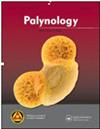New dinoflagellate cyst species from the Middle Eocene of the Volgograd-Volga region, southwest Russia
IF 1.3
4区 地球科学
Q3 PALEONTOLOGY
引用次数: 0
Abstract
AbstractThe Keresta Formation, located in the Volgograd-Volga region (the Volga-Caspian subregion of southwest Russia) has been dated as a Middle Eocene, Lutetian based on dinoflagellate cysts as the Enneadocysta arcuata Zone and nannofossils from the Lutetian Subzones CP13c-CP14a. Within this interval, four new species of dinoflagellate cysts were described: Spiniferella grigorovichiae sp. nov., Impagidinium tuberculatum sp. nov., Hystrichostrogylon crassitunicatum sp. nov. and Hystrichosphaeropsis tenerum sp. nov. The new species present a high correlation potential for Middle Eocene stratigraphy over the southern part of the Russian Platform. Also, the assemblage of organic-walled microphytoplankton from the Keresta Formation indicates warm water marine environments within the marginal part of the Paratethys Basin.Keywords: Dinoflagellate cystsMiddle EoceneLutetiansouthwest RussiaVolgograd-Volga regionDisclaimerAs a service to authors and researchers we are providing this version of an accepted manuscript (AM). Copyediting, typesetting, and review of the resulting proofs will be undertaken on this manuscript before final publication of the Version of Record (VoR). During production and pre-press, errors may be discovered which could affect the content, and all legal disclaimers that apply to the journal relate to these versions also.俄罗斯西南部伏尔加格勒-伏尔加河地区中始新世甲藻囊新种
摘要俄罗斯西南部伏尔加格勒-伏尔加地区(伏尔加-里海亚区)的Keresta组为中始新世,Lutetian为中始新世,基于鞭毛藻囊(Enneadocysta arcuata带)和Lutetian亚带CP13c-CP14a的纳米化石。在此期间,还发现了4个鞭毛藻囊新种:Spiniferella grigorovichiae sp. nov.、Impagidinium tuberculatum sp. nov.、Hystrichostrogylon crassitunicatum sp. nov.和Hystrichosphaeropsis tenerum sp. nov.,这些新种对俄罗斯地台南部中始新世地层具有较高的对比潜力。此外,Keresta组有机壁微型浮游植物的组合表明,Paratethys盆地边缘地区存在温暖的海洋环境。关键词:鞭毛藻囊肿中期初新世俄罗斯西南部伏尔加格勒-伏尔加河地区免责声明作为对作者和研究人员的服务,我们提供此版本的已接受稿件(AM)。在最终出版版本记录(VoR)之前,将对该手稿进行编辑、排版和审查。在制作和印前,可能会发现可能影响内容的错误,所有适用于期刊的法律免责声明也与这些版本有关。
本文章由计算机程序翻译,如有差异,请以英文原文为准。
求助全文
约1分钟内获得全文
求助全文
来源期刊

Palynology
地学-古生物学
CiteScore
3.40
自引率
26.70%
发文量
48
审稿时长
>12 weeks
期刊介绍:
Palynology is an international journal, and covers all aspects of the science. We accept papers on both pre-Quaternary and Quaternary palynology and palaeobotany. Contributions on novel uses of palynology, review articles, book reviews, taxonomic studies and papers on methodology are all actively encouraged.
 求助内容:
求助内容: 应助结果提醒方式:
应助结果提醒方式:


